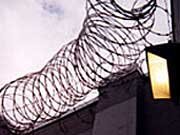|
Your Voice
|
Life After Prison
March 2, 2003
The nation's prison population the last two decades has grown to record levels. Now, a record number of those put behind bars are getting out. Many are returning to their former neighborhoods. They're looking for jobs and a place to live, and they have a prison record.
St. Paul, Minn. — There are about two million people behind bars in this country -- in county jails, state and federal prisons. Stiffer penalties for a range of crimes, from drug dealing to car theft, have swelled prison numbers the past two decades. However, most eventually get out. Last year, a record 600,000 inmates were released.
Minnesota Department of Corrections transitions coordinator Tim Lanz says the number of people released from prison in Minnesota has more than doubled in the past decade.
"Now they're up to closer to 4,000 a year, and these are just from our adult correctional facilities," Lanz says. "These are state-level felony offenders. I'm not talking about county jail people being released. I'm not talking about people out of the federal system coming to the state of Minnesota."
Many first-time offenders convicted of non-violent crimes in Minnesota are sentenced to probation rather than put behind bars. People sent to state prisons have repeatedly committed serious crimes. Lanz says many have long-standing personal problems.
"These are not people who decided to commit an offense while they were going to work one day. These are folks that have troubled pasts, troubled family backgrounds," says Lanz. "They have chemical issues, various addictions, sex addictions, gambling addictions, they have dysfunctional families, they have, many of them have mental illness. They provide us with a range of challenges that boggle the imagination."
Sheryl Ramstad, now a Minnesota Tax Court judge, was state corrections commissioner during Gov. Ventura's administration. Ramstad says many inmates arrive with an addiction problem.
"Eighty percent of our people who are incarcerated in the inmate population have chemical dependency problems," Ramstad says. "We are heavily invested in trying to provide offenders with an opportunity to address that problem -- to make meaningful changes -- so that they're not going to get out and go back through the door of the criminal justice system."
The state's budget problems are causing agencies, including the Corrections Department, to trim services. Corrections Department transitions coordinator Tim Lanz says many inmates facing release need help with the basics.
"The housing and employment are primary issues for us," Lanz says. "They pretty much have to be arranged before the man or the woman walks out the front door of that facility, otherwise it's almost an insurmountable hurdle for them."
Public antipathy towards inmates is widespread. Many employers and landlords are reluctant to have anything to do with felons. However, most manage to find a job and a place to live.
Bill Guelker, director of field services for the Minnesota Department of Corrections, says there are people with compassion for inmates. Guelker says offering ex-cons a second chance is not a matter of choice for society.
"If we don't find a way to bring a person back into a community constructively and safely, we'll ultimately reap the non-benefit of them potentially committing a crime again," Guelker says.
Inmates who were recently released from Minnesota prisons have had different experiences as they tried to adjust to life after prison. Here are stories of a few of them.
|
News Headlines
|
Related Subjects
|

